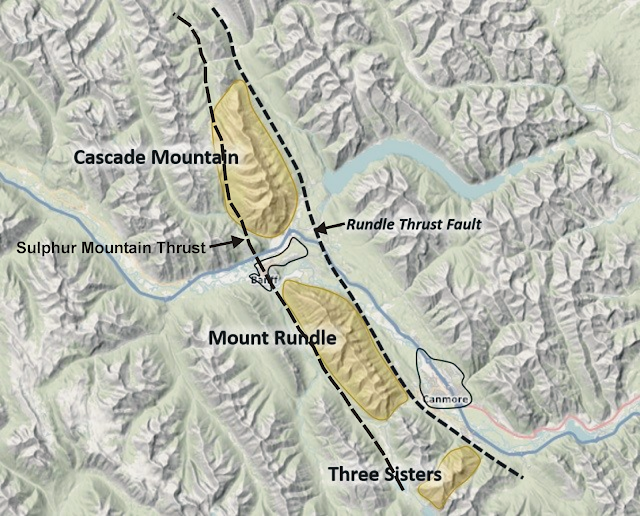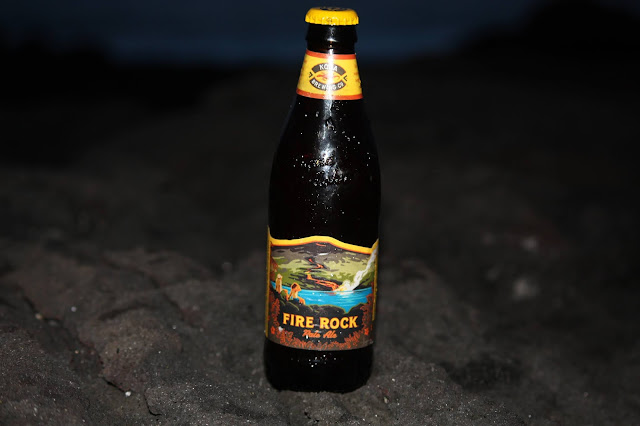Located in the heart of Banff National Park, the Park Distillery has many spirits with a geological flair to them. Besides just the name of the "Glacier Rye", the image on the bottle features one of the glaciers within Banff National Park, Crowfoot Glacier. I had previously done a Geology of the National Parks Through Pictures review of Banff National Park on my other page and talked a bit about the Crowfoot Glacier as well as many other geological features within the park.

Generally, a glacier is a body of ice that doesn't melt during the warmer summer months. It starts off as a snowfield around the higher elevations, often near the peaks of mountains. The snowfield, which also doesn't melt throughout the year, builds up more and more snow over time. Eventually, the snow reaches a thickness where it starts to compact in on itself, forming ice in the lower layers of the snowpack. Eventually this ice gets so thick that is starts to flow and slide down the mountain peaks. At this point it can be deemed a glacier. As the temperature increases down the mountain sides eventually the glacier will reach an elevation where it is too warm to remain frozen for the entire year and will melt. If the local, and really global, temperatures are stable, the glacier will reach a balancing point where the amount of snowfall and ice accumulation at the top will equal the amount of melting at the bottom and the glacier will remain the same size (however always still flowing from top to bottom). If global temperatures are decreasing, the glacier will grow until a new balance point is achieved. If temperatures are increasing, then the glacier will decrease, or even completely disappear, until a new balance point is achieved.

Text from the back of the bottle:
"We distill in the purest place on the planet. Out water originates at six Rocky Mountain glaciers, and our grain is sourced from high-altitude family farms in the Alberta foothills. Our Spirits are like no other in the world, because there is no other place in the world like Banff.
From 100% locally-farmed Alberta rye. Double pot distilled in our hand-built Kothe copper still. The remarkable nature of this 100% heart cut spirit demanded we bottle some unaged. The way a sky-blue, glacier-fed lake demands you dive right in. Which you don't. Because it's freezing [see below].
Vista - Crowfoot Mountain at Bow Lake, Banff National Park"

As noted in the description, the image on the bottle is of Crowfoot Mountain at Bow Lake. Here is a panoramic shot of Bow Lake with Crowfoot Mountain on the left side of the image. Along with the formation of a glacier, there are many different features that are characteristic of glacial landscapes. These are both erosional and depositional. When a glacier is sliding down the side of a mountain it collects the rocks, soil, and pretty much anything that gets in its way and carries it down the mountain with it. Once it reaches the end of the glacier, where the ice is melting, the glacier acts like a conveyor belt and all of the material that it is carrying gets dropped into one big pile. This big pile is called a moraine, while the debris within the moraine is called till.
Glaciers also carve out the valleys that they are travelling in. Starting as stream valleys, the profile of the valley will start out in a "V-shape" due to the stream carving down into the ground at the one central point. However, a glacier will often fill the valley it is traveling in, carving out the sides of the valley as well as the base of the valley. This will smooth out the "V", creating what is known as a "U-shaped" valley. Landscapes impacted by glaciers are often very easy to identify by these U-shaped valleys. A lot of times these features will overlap, like here at Bow Lake. Bow Lake is what is known as a moraine-dammed lake. This was a valley initially carved out by a glacier, forming a U-shaped valley. At the end of the valley, where the end (or toe) of the glacier was located, it formed a moraine. After the glacier melted away, the meltwater from the glacier flowed down into the valley but was dammed up by the moraine, forming Bow Lake that you see here.

A close up shot of Crowfoot Mountain and the Crowfoot Glacier that can be seen on the front of the bottle. The Crowfoot Glacier is part of a much larger icefield, the Wapta Icefield, all of which are found along the Icefields Parkway at Banff National Park. The icefields located within Banff and other national parks in the region, are so large that they frequently have several glaciers that stick out from them, traveling down the surrounding mountain ranges.
As the glaciers grow and slide down the mountain they form a bowl-shaped depression that they sit in known as a cirque. Eventually, should the glacier melt, the cirque, which is often cut down into the bedrock, provides an ideal location for a lake to develop. Crowfoot Glacier sits within the cirque that it has carved out and hopefully will remain there for a long time. However, with global temperatures rising, the amount of glaciers within Banff have been quickly decreasing and the size of the glaciers that are still present have all been shrinking. So, it is only a matter of time before these glaciers are gone for good.

I reemphasize what the back of the bottle says: "The way a sky-blue, glacier-fed lake demands you dive right in. Which you don't. Because it's freezing."
We visited the park towards the end of July, which is around the warmest part of the year and even then the water was COLD, because they are direct runoffs from the melting glaciers. Here is another view of Bow Lake with the Bow Glacier up in the background, another glacier that is part of the Wapta Icefield. Both Bow Glacier and Crowfoot Glacier melt into Bow Lake.
The beauty of Banff National Park can't be understated and the fact that Park Distillery highlights one of the most ideal glaciers to see along the main Icefields Parkway within the national park is no accident. This park is a sight to behold.


















































